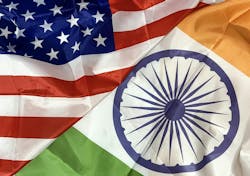US, India head for standoff over Russian oil purchases
Key Highlights
- The US announced plans to raise tariffs on Indian imports from 25% to target India's Russian oil purchases, escalating diplomatic tensions.
- India defends its Russian oil imports, citing energy security and crude quality challenges, despite US pressure and sanctions measures.
US–India positions on Russian oil purchases are rapidly escalating toward a stand-off. On Tuesday, Aug. 5, US President Donald Trump announced that he planned to significantly raise the tariff on imports from India, currently set at 25%, within the next 24 hrs. This decision comes in response to India's ongoing purchases of Russian oil.
He further remarked that a "zero tariff" proposal for US goods entering India was inadequate, claiming that India was "fueling the war" in Ukraine. Trump's warnings to India regarding its purchase of Russian oil began on Jul. 31, 2025, when he declared a 25% tariff on Indian imports, in addition to an unspecified penalty.
India’s foreign ministry said in a statement that “the targeting of India is unjustified and unreasonable.” The ministry stated that India was “actively encouraged” by the US to buy Russian oil, which American officials said at the time was meant to keep Russian oil in the global supply so that oil prices would not surge. The statement also mentioned that the EU conducted $78 billion worth of trade with Russia in 2024, including record imports of Russian LNG.
India's motivation to keep purchasing Russian oil will likely persist, as long as the country is willing to manage the repercussions of these measures while addressing its energy security challenges, said Mariano Alonso, Vice President, Commodity Markets Analysis at Rystad Energy.
“From a crude fundamentals perspective, India faces a significant crude quality challenge rather than quantity, which likely underpins its firm stance in protecting national energy interests. To resolve the stand-off, the US will probably need to offer alternative crude supply options within its sanction framework. It is likely that such an offer could emerge in the coming days,” said Alonso.
India's oil demand has risen by about 1 million b/d over the past decade, despite a temporary setback during the pandemic. Looking ahead, this demand is expected to grow by an additional 0.8 to 0.9 million b/d by 2030. In response to this demand, India's refining capacity has increased and is currently operating at nearly 5.5 million b/d, with projections indicating it may exceed 6 million b/d by 2029. Conversely, India's crude production has been declining for several years and is anticipated to drop below 0.5 million b/d by 2030.
“While recent sentiment around India’s exploration and production potential is positive, it is unlikely to be a game changer in the near term. There will still be a need for imports to stay high near 5.0 million b/d and touch levels near 5.8 million b/d by 2029-30,” said Alonso.
More importantly, India’s oil imports need to maintain a balanced mix: around 60% medium-quality barrels, 30% light barrels, and 10% heavy barrels. The need of India for medium barrels is going to grow by another 1 million b/d by 2030. The Russian barrels are in that medium-sour quality bucket.
India's increased imports from Russia under the price-cap mechanism have come with lower availability of supply from other countries owing to sanctions, OPEC+ cuts, and diversion to Europe.
US crude oil is primarily light sweet, a grade India also produces domestically and currently has limited need for. As domestic light crude production declines, India may require more light barrels, presenting an opportunity to increase US imports.
“So far, India, China and Turkey have been buying the Russian oil under the price cap mechanism set-up by the EU and not in violation of any sanctions or tariffs.
News of stricter US action targeting India for purchasing Russian barrels—but not China—has raised questions about the effectiveness of such measures,” said Alonso.
“If enforced, this could lead to further market distortions and shifts in trade flows, with increased Russian barrels heading to China while India seeks more supply from other OPEC+ members in the Middle East. If US actions were applied to both India and China, the strategy might achieve the intended impact. However, given ongoing trade negotiations with China, such a scenario appears unlikely.”
“Given the hard realities of India’s oil system and the limited effectiveness of US actions, it is unlikely that all parties involved in the Ukraine-Russia conflict will pursue an exit strategy over further escalation. The recent escalation on all sides suggests an attempt to maximize negotiation leverage before any potential resolution takes shape.”
About the Author
Conglin Xu
Managing Editor-Economics
Conglin Xu, Managing Editor-Economics, covers worldwide oil and gas market developments and macroeconomic factors, conducts analytical economic and financial research, generates estimates and forecasts, and compiles production and reserves statistics for Oil & Gas Journal. She joined OGJ in 2012 as Senior Economics Editor.
Xu holds a PhD in International Economics from the University of California at Santa Cruz. She was a Short-term Consultant at the World Bank and Summer Intern at the International Monetary Fund.

